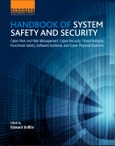Handbook of System Safety and Security: Cyber Risk and Risk Management, Cyber Security, Adversary Modeling, Threat Analysis, Business of Safety, Functional Safety, Software Systems, and Cyber Physical Systems presents an update on the world's increasing adoption of computer-enabled products and the essential services they provide to our daily lives. The tailoring of these products and services to our personal preferences is expected and made possible by intelligence that is enabled by communication between them. Ensuring that the systems of these connected products operate safely, without creating hazards to us and those around us, is the focus of this book, which presents the central topics of current research and practice in systems safety and security as it relates to applications within transportation, energy, and the medical sciences.
Each chapter is authored by one of the leading contributors to the current research and development on the topic. The perspective of this book is unique, as it takes the two topics, systems safety and systems security, as inextricably intertwined. Each is driven by concern about the hazards associated with a system's performance.
Please Note: This is an On Demand product, delivery may take up to 11 working days after payment has been received.
Table of Contents
1. Fundamentals of Systems 2. A Framework for System Development 3. Cyber-Physical Systems 4. The Business of Safety 5. Systems and Safety 6. Applications of System Safety 7. The Business of Security 8. Systems and Security 9. Application of System Security 10. Evolving Security 11. Distributed and Cloud Computing 12. Mobile Computing 13. Smart Grid 14. Smart Grid Algebra: A Formal Language for Design and Test
Authors
Edward Griffor Associate Director for Cyber Physical Systems, National Institute of Standards.Dr. Edward Griffor is the Associate Director for Cyber Physical Systems at the National Institute of Standards and Technology (NIST) in the US Department of Commerce. Prior to joining NIST in July of 2016, he was a Walter P. Chrysler Technical Fellow, one of the highest technical positions in the automotive industry and one that exists in multiple industry sectors, including transportation, aerospace, science, defense, energy and medical. He served as Chairman of the Chrysler Technology Council until 2015 and continues to serve as Chairman of The MIT Alliance, a professional association of scientists, engineers, and business experts trained at the Massachusetts Institute of Technology.
Dr. Griffor completed doctoral studies at MIT in Mathematics at MIT and was awarded Habilitation in Mathematics and Electrical Engineering by the University of Oslo. He was named National Science Foundation/NATO Postdoctoral Fellow in Science and Engineering. Dr. Griffor was on the faculty of Uppsala University in Uppsala, Sweden from 1980 to 1997 and returned to the US to lead advanced research in Electrical Engineering in the automotive industry.
Dr. Griffor has been on the faculties of the University of Oslo in Norway, Uppsala University in Sweden, the Catholic University of Santiago in Chile as well as those of Harvard, MIT and Tufts University in the U.S. He is regarded as one of the world experts in the use of mathematical methods for the design and assurance of technologies used in developing advanced, adaptive cyber physical systems, including those used to ensure the safety and security of autonomous systems. In addition to his work at Chrysler, Dr. Griffor has led research in biosystem modeling and simulation. He is Adjunct Professor at Wayne State University School of Medicine in Detroit, MI at the Center for Molecular Medicine and Genetics.
Dr. Griffor's work in the automotive industry provided advanced algorithms for Voice Recognition and Autonomous and Connected Vehicles. Dr. Griffor has published three books previously, including Handbook of Computability by Elsevier, Theory of Domains, by Cambridge University Press, and Logic's Lost Genius: The Life of Gerhard Gentzen by American Mathematical Society. He has published extensively in professional journals and has given invited presentations for the American Mathematical Society, Association for Symbolic Logic, North American Software Certification Consortium, Society of Automotive Engineers, the Federal Reserve Bank and US government agencies, including NIST, DARPA, DOE, DOT and NASA.








